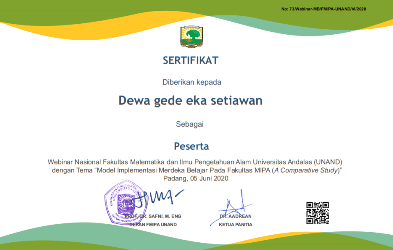Riset dan Peluang Kerja

Webinar Merdeka Belajar

METODE PENGUKURAN ENERGI GELOMBANG PASANG SURUT BERDASARKAN REKAMAN CITRA TIMELAPSED PERMUKAAN FLUIDA
Dewa Gede Eka Setiawan, Gede Bayu Suparta
Metode pengukuran energi gelombang pasang surut berdasarkan rekaman citra timelapsed permukaan fluida telah dilakukan. Eksperimen simulasi gelombang pasang surut dihasilkan dari pengaturan pompa air yang dikontrol oleh solenoid valve menuju suatu pipa pengamatan. Air yang dilewatkan pada pipa transparan sebagai permukaan fluida menggambarkan gelombang pasang surut yang dapat diamati menggunakan CCD kamera. Frekuensi gelombang pasang surut dihasilkan dari bukatutup frekuensi solenoid valve karena frekuensi buka tutup solenoid valve beroperasi maka pasang surut berubah sebagai fungsi waktu dan bisa diamati menggunakan metode perekaman citra timelapsed. Persamaan pasang surut dikembangkan berdasarkan perekaman citra. Persamaan ini diperoleh dari hasil menggunakan persamaan lagrange. Hasil simulasi mendekati hasil dari perhitungan menggunakan persamaan lagrange. Hasil eksperimen menunjukan sifat kuantitas fisika seperti periode osilasi, frekuensi, amplitudo, dan kecepatan gelombang dapat dihitung besar energi pasang surut. Energi gelombang pasang surut permukaan fluida sebagai variasi frekuensi solenoid valve sebesar 4 Hz, 2 Hz dan 0,67 Hz berturut-turut dihasilkan energi gelombang sebesar 3,25x10-2 joule, 15,33x10-2 joule dan 198,24x10-2 joule. Dengan asumsi frekuensi gelombang datang sesuai dengan frekuensi buka-tutup solenoid valve, maka frekuensi pasang surut mempengaruhi energi gelombang pasang surut yang dihasilkan. sehingga kesimpulannya bahwa frekuensi gelombang pasang surut mempengaruhi hasil energinya.Semakin kecil frekuensinya semakin besar energi gelombang yang dihasilkan pada permukaan fluida.
A method on measurement of a tidal wave energy based on time lapsed image recording of the surface of fluid has been carried out. Experimental simulation has been developed using pumped water flow that was controlled by a solenoid valve. The water was passed through a transparent tube in which the surface of the fluid as a representation of the tidal wave can be examined using a CCD camera. The frequency of the tidal wave was resulted from open-close frequency of the solenoid. As the open-close frequency of the solenoid was run, a tidal change as a function of time can be examined using a time lapsed image recording method. The tidal pattern was developed based on the images recorded. The tidal pattern was then compared by pattern resulted from lagrange formulation. The pattern resulted from simulation was similar to the pattern resulted from lagrange formulation. The results of the experiment showed that the physical quantities such as the period of oscillation, frequency, amplitude and speed of wave can be calculated to yield the tidal energy. The tidal wave energy of the fluid surface as a variation of frequency for solenoid valve 4Hz, 2Hz and 0,67Hz yield wave energy of 3.25x10-2 Joules, 15.33x10-2 Joules and 198.24x10-2 Joules respectively. Assuming the open-close solenoid was proportional to the frequency of the tidal oscillation, then it was concluded that the frequency of tidal wave affects the resulting of energy. The lower the frequency, the higher the tidal wave energy.
Kata Kunci : energi gelombang, pasang surut fluida, perekaman timeplased.
ANALISIS SEBARAN LAVA BANTAL WATUADEG YANG DIDUKUNG DATA VERTICAL ELECTRICAL SOUNDING (VES) DI LAPANGAN 'AGSTY' YOGYAKARTA
Nurul Dzakiya, Muhammad Agsti Buana Aditya, Harsano Jayadi, Dewa Gede Eka Setiawan
Abstract
Analisis sebaran lava bantal Watuadeg di Kecamatan Berbah DI Yogyakarta yang didukung data Vertical Electrical Sounding (VES )telah dilakukan.Keterdapatan lava bantal yang tersingkap di permukaan merupakan penanda bahwa dahulu daerah tersebut merupakan laut. Akibat proses geologi terutama tektonik mengakibatkan lava bantal tersebut terangkat kedaratan. Lava bantal yang belum tersingkap karena tertutup oleh soil (lapukan batuan) menjadi daya tarik tersendiri untuk dikaji. Persebaran lava bantal permukaan dominan mengalir dari sumbernya ke arah selatan dan menyebar ke tenggara serta dibatasi oleh Sungai Opak. Berdasarkan hasil analisis data VES, keberadan lava bantal di lokasi titik pengukuran berada di kedalaman 4 m dengan nilai resistivitas sebesar 1321,08 Ωm. Berdasarkan dari data geologi dan nilai resistivitas batuan tersebut dapat disimpulkan bahwa penyebaran lava bantal dominan ke arah selatan dari pusat erupsinya dengan sayap sebaran ke arah tenggara dan barat daya serta sebarannya masih ada di bawah permukaan
Keywords
Lava Bantal; Watuadeg; Berbah; Vertical Electrical Sounding
Analysis of Clay Silt Reserve Using Geoelectricity in the Village of Dulohupa District of Gorontalo
Dewa Gede Eka Setiawan
Abd. Wahidin Nuayi
Universitas Negeri Gorontalo
Abstract
This research aims to investigate clay silt reserve in brick farmer area. This research applies geoelectricity by using Schlumberger configuration conducted by doing injection of electric current with low frequency to surface of earth. Value of resistance will bring information about structure and materials across by it.
Research site is in four stations and based on the geographical location in the station I at coordinate N 00 ° 35'43.7 ", E 123 ° 03'41.6" directed to east west, station 2 in coordinate N 00 ° 35'43.8 ", E 123 o 03'41.4 "directed to north south, station 3 in coordinate N 00 ° 35'42.4", E 123 ° 03'41.5 "directed to north south and station 4 in coordinate N 00 ° 35'45.4", E 123 ° 03 '42 .1 "directed to south north. Research finding reveals that depth or density of clay silt ie in S1 is 8 m, in S2 is 2.5 m, in S3 is 7 m while in S4 is 8,5 m. Density in S2 is the thinnest is the river thinnest gravel and sand are found there. Then, based on the four points after straight line is drawn, it shapes geometry which makes the volume of clay silt reserve can be calculated. And based on finding of measurement and calculation, it obtains volume of clay silt reserve in the village of Dulohupa for 15000 m3.
DOI: https://doi.org/10.30871/jagi.v1i2.516
Keywords: Geoelectricity, Schlumberger, Silt, Clay
